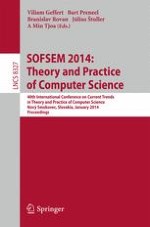2014 | Book
SOFSEM 2014: Theory and Practice of Computer Science
40th International Conference on Current Trends in Theory and Practice of Computer Science, Nový Smokovec, Slovakia, January 26-29, 2014, Proceedings
Editors: Viliam Geffert, Bart Preneel, Branislav Rovan, Július Štuller, A Min Tjoa
Publisher: Springer International Publishing
Book Series : Lecture Notes in Computer Science
